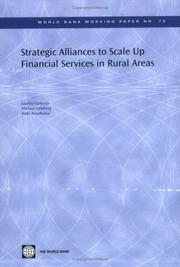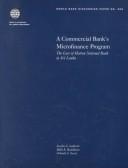| Listing 1 - 10 of 12 | << page >> |
Sort by
|
Book
Year: 1997 Publisher: Washington, D.C.
Abstract | Keywords | Export | Availability | Bookmark
 Loading...
Loading...Choose an application
- Reference Manager
- EndNote
- RefWorks (Direct export to RefWorks)
Book
Year: 2002 Publisher: Washington, D.C. : World Bank, Financial Sector Development Department,
Abstract | Keywords | Export | Availability | Bookmark
 Loading...
Loading...Choose an application
- Reference Manager
- EndNote
- RefWorks (Direct export to RefWorks)
How does a country's legal and regulatory framework affect the sustainability of microfinance? Does a tiered approach to regulation help to integrate microfinance into the formal financial system? And are there lessons to be learned from the experience of Ghana and the Philippines with a tiered approach?
Financial services industry --- Microfinance --- Small business --- Law and legislation --- Finance.
Book
Year: 1997 Publisher: Washington, DC : World Bank, Financial Sector Development Department,
Abstract | Keywords | Export | Availability | Bookmark
 Loading...
Loading...Choose an application
- Reference Manager
- EndNote
- RefWorks (Direct export to RefWorks)
Industrial equipment leases --- Leases --- Small business --- Finance.
Book
Year: 1999 Publisher: Washington, D.C.
Abstract | Keywords | Export | Availability | Bookmark
 Loading...
Loading...Choose an application
- Reference Manager
- EndNote
- RefWorks (Direct export to RefWorks)
Digital
Year: 2005 Publisher: Washington, D.C. World Bank
Abstract | Keywords | Export | Availability | Bookmark
 Loading...
Loading...Choose an application
- Reference Manager
- EndNote
- RefWorks (Direct export to RefWorks)

ISBN: 0821366033 0821366041 9780821366035 Year: 2006 Publisher: Washington, D.C. World Bank
Abstract | Keywords | Export | Availability | Bookmark
 Loading...
Loading...Choose an application
- Reference Manager
- EndNote
- RefWorks (Direct export to RefWorks)
Development aid. Development cooperation --- World Bank --- India --- Philippines --- Ghana --- Guatemala

ISBN: 0821366033 0821366041 9780821366035 9786610413737 1280413735 Year: 2006 Publisher: Washington, D.C. : World Bank,
Abstract | Keywords | Export | Availability | Bookmark
 Loading...
Loading...Choose an application
- Reference Manager
- EndNote
- RefWorks (Direct export to RefWorks)
Business firms have employed strategic alliances with other firms to effectively manage costs, overcome resource and technology constraints, and enhance competitive position. The principle and practice of strategic alliances can be applied as well for productive and beneficial institutional collaborations in rural financial markets to expand the array of financial products and to scale up access of rural households and micro-businesses to financial services.Strategic alliances comprise a new theme in rural finance. The institutions in the study used strategic alliances to tap new capital resou
Development aid. Development cooperation --- World Bank --- India --- Philippines --- Ghana --- Guatemala --- Microfinance --- Rural development --- Rural credit --- Financial institutions --- Strategic alliances (Business) --- Alliances in business --- Business alliances, Strategic --- Corporate alliances --- Strategic business alliances --- Strategic corporate alliances --- Strategic partnerships (Business) --- Partnership --- Business networks --- Credit

ISBN: 0821340026 Year: 1997 Publisher: Washington, D.C.
Abstract | Keywords | Export | Availability | Bookmark
 Loading...
Loading...Choose an application
- Reference Manager
- EndNote
- RefWorks (Direct export to RefWorks)
Book
Year: 2005 Publisher: Washington, D.C., The World Bank,
Abstract | Keywords | Export | Availability | Bookmark
 Loading...
Loading...Choose an application
- Reference Manager
- EndNote
- RefWorks (Direct export to RefWorks)
The authors investigate the microfinance regulatory regimes in Benin, Ghana, and Tanzania, with a view to identifying key issues and lessons on how the overall regulatory framework affects integration of microfinance institutions into the financial system. The authors find that recognizing different tiers of both regulated and unregulated institutions in a financial structure facilitates financial deepening and outreach to otherwise underserved groups in urban and rural areas. That environment promotes sustainable microfinance under shared performance standards and encourages regulatory authorities to develop appropriate prudential regulations and staff capacity. Case studies of the three countries raise important issues on promoting microfinance development vis-a-vis regulating them. Laws to regulate activities other than intermediation of public deposits into loans can result in disproportionately restrictive and unmanageable standards, even as dynamic microfinance sectors have emerged without conducive regulatory regimes. The authors use the three countries' regulatory experiences to highlight the importance of differentiating when prudential supervision is warranted and when regulatory oversight suffices, and to identify the agencies to carry out regulation. They address an important issue that has received scant attention, measuring and paying for the costs of regulating microfinance, and the need to build technical capacity of supervisory and regulatory staff.
Bank --- Banks and Banking Reform --- Banque Centrale Des Etats De L'afrique De L'ouest --- Capital Adequacy --- Cred Credit Unions --- Debt Markets --- Deposits --- Emerging Markets --- Finance and Financial Sector Development --- Financial Deepening --- Financial Institutions --- Financial Literacy --- Financial Structure --- Financial Systems --- Laws --- Legal Framework --- Legislation --- Loans --- Microfinance --- Private Sector Development --- Prudential Regulations --- Regulatory Framework --- Reserve Requirements --- Risk --- Rural Banks
Book
Year: 1999 Publisher: Washington, DC (1818 H St., NW, Washington 20433) : World Bank, Financial Sector Development Dept.,
Abstract | Keywords | Export | Availability | Bookmark
 Loading...
Loading...Choose an application
- Reference Manager
- EndNote
- RefWorks (Direct export to RefWorks)
Financial services industry --- Microfinance. --- Government policy.
| Listing 1 - 10 of 12 | << page >> |
Sort by
|

 Search
Search Feedback
Feedback About UniCat
About UniCat  Help
Help News
News